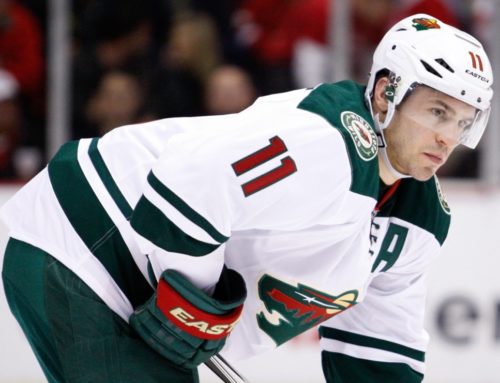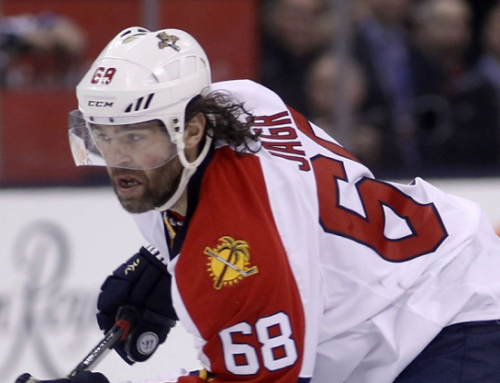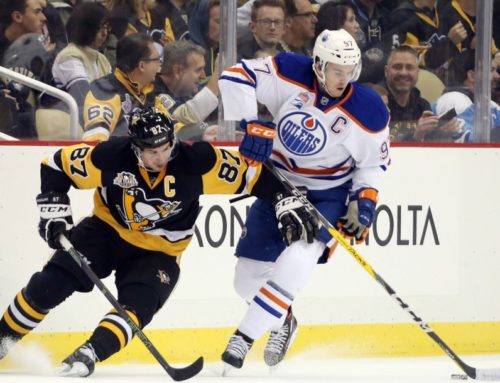
Demetri combs through some European league data to try to find an answer to the goal-scoring shortage.
Theodore Roosevelt once said “Speak softly and carry a big stick”. Many subscribed to his words as they often would reach for a wooden spoon or ruler to deter kids from certain behaviors and actions.
Ironman’s alter ego, Tony Stark, modernizes the old phrase by saying, “Peace means having a bigger stick than the other guy,” and not too coincidentally NHL goalies tend to look a lot like the first version of the Iron Man suit these days.
Lately many have commented about the size of their equipment and also the lack of penalties as the culprits for the reduction of goal scoring that the NHL is facing.
TSN’s Ray Ferraro echoes those sentiments. Scott Lewis of Sportsnet reports a similar account, but includes changing the nets.
Back in the summer Damien Cox came up with a magic number: seven goals per game. But he did not really offer much in terms of a solution; only that the league should ‘tinker’ with the system. If only it were as simple as turning a dial on a control board.
We are going to explore the aspect of penalty minutes and goalie equipment.
When it comes to hockey we have a myopic, NHL-centralized view. What if I told you that other leagues are dealing with lower penalty totals as well? Don’t believe me… here is the chart (raw data compiled from hockeydb.com, wikipedia.org, Swiss Ice Hockey Federation, Finland SM-liiga, KHL, and Swedish Hockey League):

The trend since 2000-01 is that players are taking fewer penalties. It does not matter if they play in the NHL, KHL, or another European professional league.
I have no expertise in those other leagues. I cannot tell you what changes they made to their rules, but I can tell you that the NHL started using the two-referee system in the 2000-01 season.
Simply suggesting that NHL referees call more penalties does not change the fact that this is systemic across all hockey. Players have adapted.
Here is what the various goals per game values look like for each league (again the same sources for the data):

The trend in those leagues is to be down, with the exception being in Russia, where under the Russian Superleague scoring was below five goals a game and now with the KHL it has recently passed six goals per game.
The KHL was trending downward from its inception (2008-09), but I do know that they added a consolation bracket for teams that do not make the playoffs in their 2012-13 season. While these statistics are based on regular season values, knowing that players do not mail it in once their teams are officially eliminated suggests it helps the goal totals.
You could look at these to charts and say, “That is exactly the point, penalty minutes are down, so scoring is down. We need more penalties to be called,” but you would be incorrect.
We’ll go through the individual leagues one by one, Austrian League:

PIM / Game and POT % (Percentage of teams that make the playoffs) use the scale to the left hand side.
Goals / Game and Goals / PIM / Game * 1000 use the scale to the right hand side. The Goals / PIM / Game is a really small value which is why I multiply it by 1000, so it can be distinguished easily on the chart.
We do see dips and rises with the PIM / Game and Goals / Game values that seem to follow each other, but later on the PIM / Game values continue to decline severely while the Goals / Game value decline moderately.
This is seen better with the Goals / PIM / Game * 1000 values. That means that players are generating more goals based on fewer penalties per game.
Czech Republic League:

I like this league because it is has been consistent. Same number of teams and games played, but they added two more teams to the playoffs in the 2006-07 season.
Their Goals / Game values hover in the fives even though the total number of penalty minutes decreased since 2006-07. Another thing to note, in that season where penalties spiked, the Goals / Game ratio was not that much better than what it is now.
Deutsch Eishockey League:

Their Goals / PIM / Game * 1000 values have steadily improved.
Finland SM-liiga:

Also another league that has been very steady in terms of the number of teams and games played each season. The number of goals per game is down but within range of past values, yet there are about 10 penalty minutes fewer each game. Also note that when there was as spike in penalty minutes it did not necessarily improve the goal scoring rate.
Russian Superleague / KHL:

The Percentage of teams that make the playoffs (POT%) here only shows the true playoffs, not the consolation bracket. But if it were to be included, the values would be at or near 100 percent.
As mentioned before, even with penalty minutes being relatively flat since 2012 the goal scoring rate went up.
Swedish Hockey League:

Yet another league that has been consistent and stable. They play 60 more games each year since the 2006-07 season and it took them a while to improve upon their Goals / PIM / Game * 1000 value.
Switzerland National League A:

Their Goals / Game ratio is almost the same from the 2000-01 season to the 2014-15 season yet they have 10 fewer penalty minutes per game now.
I think this is ample data to indicate that increasing the number of penalties that are called is not a solution to generate more goals. It also shows that Cox’s ideal value of seven goals per game is unrealistic seeing as the Austrian league was the only one that ever had that many goals scored.
Does that mean that problem lies with the goalie equipment?
Before we attempt to answer that question, we have to admit that player safety is paramount and any suggestion to put goalies at risk is not acceptable.
While researching for this segment I came across this History of Hockey Equipment marketing document by Reebok on the Dallas Stars site. Interesting to read about all the innovations and that some were actually causing more harm than not.
Two items that I would like to highlight are 1) In 1981 the NHL allowed aluminum shaft sticks, and 2) In 1994 the NHL approved composite sticks.
The aluminum shafted sticks were light but very rigid. The technology was that you either glued or locked the wooden blade into the shaft. They did have a tendency to break at the connection though.
Composite sticks did not have that particular design flaw. The first models broke frequently but were improved upon so much that I do not believe that any professional player (outside of goalies) use wooden sticks anymore.
Greater flexibility meant that pucks could be launched are greater speeds. There is a whole slew of data on it.
But are the composite sticks that much better than the older wooden sticks? Shouldn’t we see an increase in scoring from the implementation of this new technology?
Manufacturers can develop something that can fling a puck at over 100 miles per hour but that does not mean that it will be more accurate. In Al Strachan’s book “Over the Line: Wrist Shots, Slap Shots and Five-Minute Majors,” he questions the same thing.
He writes, “Both men won the Norris Trophy as the NHL’s best defensemen – Wilson in 1982 and MacInnis in 1999 – and each is convinced that the composite sticks do nothing for the game. In fact, they feel that the introduction of the composite sticks is a significant factor in the reduction in scoring.”
Continuing, “Supporters of composite sticks say that they give ordinary players a tremendous shot. And that’s true. But where is that shot going? If it’s on the net, it may well be 20 mph faster than its counterpart from a wooden stick and may therefore beat a goalie when another shot wouldn’t. But composite sticks are nowhere near as accurate as wooden sticks, so any gain from speed is negated by the lack of accuracy.”
He concludes “Still, players love to have booming shots, and, for the most of them, the only way to get one is to have a composite stick.” If it is good enough for some players then it must be good enough for every player.
No one wants to be left behind. They don’t want to be the outsider that used a wooden stick. As this National Post article describes about Paul Coffey’s son, “Blake went to a hockey camp and he was the only kid there with a wooden stick and the other kids were laughing at him. I told him he could use a different stick, but it had to be because he wanted to – not because he was being laughed at. Blake Coffey switched sticks.”
It is those booming shots from every player that gave goalies the excuse to safeguard their bodies and more importantly their stats.
Goalies, of course, do not want to get hurt so they start adding more padding to their already larger physiques, thus making themselves bigger and wider than ever before. Can you blame them for doing so?
It is a convenient argument but do not fool yourselves though. Goalies do not care about the risk of being injured from a slap shot.
We all remember the gruesome Clint Malarchuk accident, but nowhere in the league’s rule book (2012-13 version) does it even mandate that goalies have to wear neck protection. Steve Farnham calculated that 28% of goalies did not wear any type of neck gear in 2012.
Odd isn’t it, but not surprising. When safety could impede their ability to block a shot, safety takes a back seat. When safety concerns reinforce their wants to be able to prevent more goals, well then safety is a priority.
Composite sticks are not going to go away, but I am hoping that a player out there decides to give wooden sticks a chance again. Like LP records, maybe it will find a niche clientele.
As for the pads of the goalies, it will be very hard to streamline or shrink what they already have. The optics will be bad if a goalie gets injured after a reduction. What the league could do, though, is take away their big sticks.
Seriously, the league should lay down the lumber and mandate goalies play with a regular player’s composite stick instead of that big paddle of theirs. It will not impact any of their safety concerns, but it might just open up their five-holes.
It is time to speak softly and take away their shtick.






 ANA
ANA UTA
UTA MIN
MIN CAR
CAR MTL
MTL NYI
NYI VGK
VGK DET
DET
